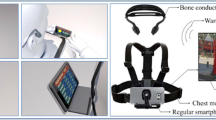Abstract
This paper presents a wearable system which can provide walking-aids for visual-impaired people in an outdoor environment. Unlike many existing systems that rely on stereo cameras or combination of other sensors, the proposed system aims to do the job by using just single camera mounted at user’s belly. One of the main difficulties of using single camera in outdoor navigation task is the discrimination of obstacles with cluttered background. To solve this problem, this paper makes use of the inhomogeneous re-sampling property of top-view transform. By mapping the original image to a top-view virtual plane using top-view transform, background edges in the near-field are sub-sampled while obstacle edges in the far-field are oversampled. Morphology filters with connected component analysis are used to enhance obstacle edges as edge-blobs with larger size, whereas sparse edges from background are filtered out. Based on the identified obstacles, safe path can be estimated by tracking a polar edge-blob histogram on the top-view domain. To deliver the safe direction to the user, an audio message interface is designed. The system is tested in different outdoor scenes with complex road conditions, and its efficiency has been confirmed.
Access this chapter
Tax calculation will be finalised at checkout
Purchases are for personal use only
Similar content being viewed by others
References
D. Dakopoulos, N.G. Bourbakis, Wearable obstacle avoidance electronic travel aids for blind: a survey, IEEE Trans. Syst. Man Cybern. 40(1), 25–35, (2010)
L.A. Johnson, C.M. Higgins, A navigation aid for the blind using tactile-visual sensory substitution, in Proceedings of 28th Annual International Conference of the IEEE Engineering in Medicine and Biology Society, pp. 6268–6292, NewYork, 2006
N. Bourbakis, Sensing 3D dynamic space for blind. IEEE Eng. Med. Biol. Mag. 27(1), 49–55 (2008)
D. Dakopoulos, S.K. Boddhu, N. Bourbakis, A 2D vibration array as an assistive device for visually impaired, in Proceedings of 7th IEEE International Conference Bioinformatics and Bioengineering, vol. 1 (Boston, 2007), pp. 930–937
S. Meers, K. Ward, A substitute vision system for providing 3D perception and GPS navigation via electro-tactile stimulation, in Proceedings 1st International Conference Sensing Technology, pp. 21–23, Palmerston North, 2005
A. Rodríguez, J.J. Yebes, P.F. Alcantarilla, L.M. Bergasa, J. Almazán, A. Cela, Assisting the visually impaired: obstacle detection and warning system by acoustic feedback. Sensors 12(12), 17476–17496 (2012)
A. Hub, J. Diepstraten, T. Ertl, Design and development of an indoor navigation and object identification system for the blind,in Proceedings of ACM SIGACCESS Accessibility Computing, pp. 147–152, New York, Jan 2004
G. Sainarayanan, R. Nagarajan, S. Yaacob, Fuzzy image processing scheme for autonomous navigation of human blind. Appl. Softw. Comput. 7(1), 257–264 (2007)
Q. Lin, Y. Han, Safe path estimation for visual-impaired people using polar edge-blob histogram, in Lecture Notes in Engineering and Computer Science: Proceedings of The World Congress on Engineering and Computer Science, WCECS 2013, pp 401–405, San Francisco, 23–25 Oct 2013
M. Bertozzi, M. Broggi, GOLD: a parallel real-time stereo vision system for generic obstacle and lane detection. IEEE Trans. Image Proc. 7(1), 62–81 (1998)
J.H. Yu, H.I. Chung, H.S. Hahn, Walking assistance system for sight impaired people based on a multimodal transformation technique, in Proceedings of ICROS-SICE International Joint Conference, pp. 1639–1643. Tokyo, Aug 2009
Acknowledgment
This research is supported by Next-Generation Information Computing Development Program through the National Research Foundation of Korea(NRF) funded by the Ministry of Education, Science and Technology (No. 2012M3C4A7032182)). This work (Grants No. C0119991) is also supported by Business for Cooperative R&D between Industry, Academy, & Research Institute funded by Korea Small and Medium Business Administration in 2013.
Author information
Authors and Affiliations
Corresponding author
Editor information
Editors and Affiliations
Rights and permissions
Copyright information
© 2014 Springer Science+Business Media Dordrecht
About this paper
Cite this paper
Lin, Q., Han, Y. (2014). A Wearable Walking-Aid System For Visual-Impaired People Based on Monocular Top-View Transform. In: Kim, H., Ao, SI., Amouzegar, M. (eds) Transactions on Engineering Technologies. Springer, Dordrecht. https://doi.org/10.1007/978-94-017-9115-1_38
Download citation
DOI: https://doi.org/10.1007/978-94-017-9115-1_38
Published:
Publisher Name: Springer, Dordrecht
Print ISBN: 978-94-017-9114-4
Online ISBN: 978-94-017-9115-1
eBook Packages: EngineeringEngineering (R0)




